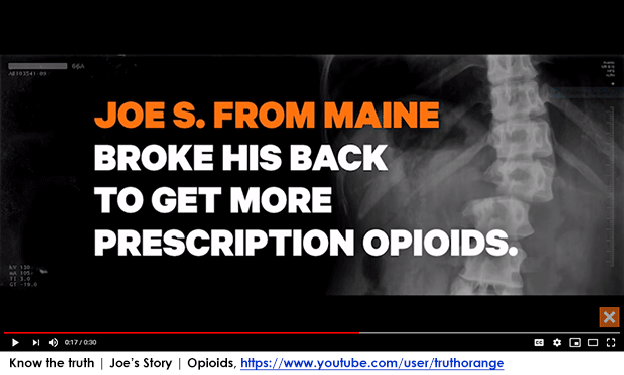What will it take to staunch the opioid epidemic currently gripping American communities? No one would argue that single stand-alone interventions will work. However, a growing number of people are putting a lot of hope into riveting new advertisements. The intent is to break the stigma of opioid dependency – and showcase the harsh reality behind it.
But while this million-dollar, Emmy-winning ad campaign may be laudable, we’re not yet convinced it’s enough to make a meaningful impact and truly help people avoid the scourge of addiction. Keep reading to find out why.
The Case for a Campaign: Why Experts Exalt Harsh Anti-Opioid Ads
In a recent New York Times op-ed, readers were asked to imagine what would happen if advertising companies launched an anti-opioid campaign mimicking a wildly successful anti-tobacco campaign that’s now over two decades old.
The latter, famously called the Truth campaign, started in the 1990s. It largely achieved a decrease in teen smoking rates in states like Florida by nearly 18% in just two years. Simultaneously, the author of the op-ed concedes that it was more than the ads that helped decrease the prevalence of smoking among teens. Citing other major and even cultural changes like raising taxes on tobacco products and widespread bans on indoor smoking. She does endorse the ads as “crucial.” Many other health experts agree.
For over 26 years, people from all over the world have chosen Waismann Method as their opioid detox provider.
We know the challenges you face and the importance of creating a unique and personal experience for you right from the start.Call for Detox Options 1-800-423-2482
Enter The Truth About Opioids, the next iteration of hard-hitting imagery and no-nonsense advertisements aimed at a young audience with the hopes of keeping them off prescription and illicit opioids, including heroin and fentanyl. These ads show shocking (and, marketers hope, relatable) images of young people detoxing from prescription opioids and purposefully injuring themselves to procure a new opioid prescription, among other things.
The goal of these ads was to induce a “shock and awe” or “scared straight” reaction. One series of ads features a fictionalized account of a young man getting underneath a parked car and kicking out the jack so that the car falls on him. Far from suicidal, his behavior is an attempt to get a prescription for painkillers from a physician. Another ad follows a young woman going through real opioid withdrawal.
Hoping for a Solution
So many people hold high hopes for these difficult-to-watch advertisements because they touch on immediate consequences instead of longer-term effects. The popular anti-tobacco campaign has been effectively capitalizing on this idea for year. To reiterate, teens and young adults are less scared of future ailments (say, lung cancer in your sixties) than more immediate consequences, like wasted money, wrinkly skin, rotten teeth. Additionally, in the case of opioids, they fear unexpected addiction, traumatic withdrawals, and accidental overdose.
Savvy marketing pros and public health officials exalt the powerful anti-drug message as an effective weapon against the opioid epidemic. But as Tina Rosenburg, the author of the NYT op-ed admits herself, it’s still “too soon to know if these ads reduce youth opioid misuse.”
We have not convinced it ever will.
Going Beyond the Ad Campaigns: Helping the People Overcome Opioid Use
Here’s the reality: teens and young adults are smart. They don’t need others to speak to them like little kids. When given a chance, they are often able to integrate truthful messages and difficult realities without the need for sugar-coating.
Young people also have their own perspectives, preferences, and needs that will influence the types of mass messaging they’ll respond to. This is often in a way that is different from adults. Any ad campaign designed by people who understand how to engage with youth audiences can make an impact.
But will that impact be enough to actually make a practical difference by reducing the rates opioid use disorder? We’re doubtful, though it’s not because we question The Truth About Opioids campaigners’ intention. Instead, we share many others’ expert opinions that raising awareness about something as life-altering as opioid dependency does not inherently scale to addiction prevention. Awareness, while certainly good and likely necessary, is not sufficient to foster meaningful change.
Why? In our view, it’s a matter of shifting the front-end focus.
Consider that both anti-drug ads and conventional opioid use disorder treatment programs overwhelmingly focus on the consequences of dependency, as well as ways to manage these consequences (rather than ways to prevent them). The causes of dependency are not readily explored and highlighted. These causes, or factors, are often the underlying, highly personal issues that individuals face. Moreover, many of these individuals are already at-risk for dependency in the first place.
As we’ve said before, opioids have a tremendous ability for masking emotional distress, including the long-lasting, psychological, biological, and neurochemical effects of trauma, depression, and anxiety. These factors often tip people environmentally and/or genetically predisposed to addictive behaviors over the edge into full-blown dependency. It is astounding how quickly this can happen and how all demographics are at risk of the dangers of opioids. Furthermore, no demographic is exempt from the emotional costs of living in our high-stress, modern world.
Opioid Use Disorder is Treatable
In other words, society shouldn’t view opioid use disorder as some “abnormal” disease process, but rather a coping strategy. Nonetheless, an ineffective and uncontrollable way to cope that people often use in response to underlying mental and emotional distress.
In this view, the remedy for opioid use goes far beyond shock-and-awe videos. Our nation is hurting for proper funding and government support of mental and behavioral health programs that can assist individuals and provide them with the necessary healing and skills to recover and reclaim their autonomy, productivity, purpose, and joy in their lives. If programs received more funding and more societal support, we would see fewer opioids and other drug addiction cases nationwide.
It is far time we remove our blinders surrounding this issue. The link between substance use disorder and mental illness is well-corroborated by evidence. It’s known that drug use is often an ill-advised attempt to self-medicate and mitigate mental and emotional problems. Then, it follows that tackling substance use disorders without at the same time or even preferentially tackling mental health disorders is bound to fall short.
Conclusion
Deterring our younger generations against opioids – and the risk of a subsequent opioid use disorder is no doubt an important step in the charge against America’s opioid epidemic. But showing young audiences the sobering realities of chemical dependency isn’t enough to avoid the dire consequences of opioid misuse.
At the Waismann Method® Opioid Treatment Center, our goal is to bridge the gap between opioid use, behavioral reality, and the emotional, mental, and spiritual underbellies of addiction. Thanks to our effective medically assisted opioid use treatment, patients can quickly and safely detox from opioids. Therefore, they are better physically and mentally prepared to do the real work of recovery. Individual mental health counseling and healing is the first step to win the opioid crisis.
To learn more about rapid detox and other medical opiate treatment options, contact Waismann Method® staff today at (800) 423-2482.






